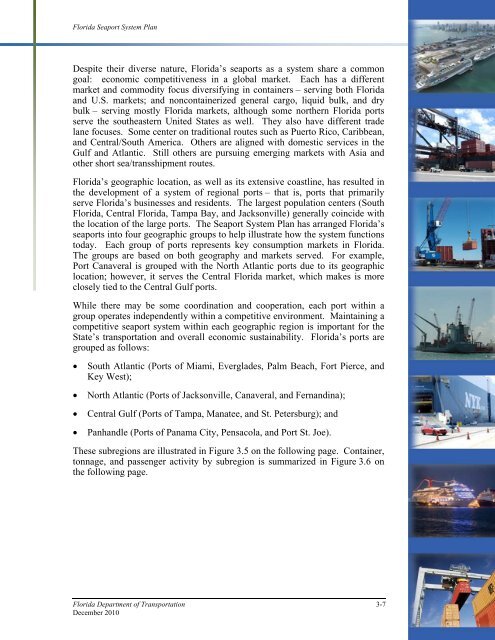Florida Seaport System Plan - SeaCIP
Florida Seaport System Plan - SeaCIP
Florida Seaport System Plan - SeaCIP
Create successful ePaper yourself
Turn your PDF publications into a flip-book with our unique Google optimized e-Paper software.
<strong>Florida</strong> <strong>Seaport</strong> <strong>System</strong> <strong>Plan</strong><br />
Despite their diverse nature, <strong>Florida</strong>’s seaports as a system share a common<br />
goal: economic competitiveness in a global market. Each has a different<br />
market and commodity focus diversifying in containers – serving both <strong>Florida</strong><br />
and U.S. markets; and noncontainerized general cargo, liquid bulk, and dry<br />
bulk – serving mostly <strong>Florida</strong> markets, although some northern <strong>Florida</strong> ports<br />
serve the southeastern United States as well. They also have different trade<br />
lane focuses. Some center on traditional routes such as Puerto Rico, Caribbean,<br />
and Central/South America. Others are aligned with domestic services in the<br />
Gulf and Atlantic. Still others are pursuing emerging markets with Asia and<br />
other short sea/transshipment routes.<br />
<strong>Florida</strong>’s geographic location, as well as its extensive coastline, has resulted in<br />
the development of a system of regional ports – that is, ports that primarily<br />
serve <strong>Florida</strong>’s businesses and residents. The largest population centers (South<br />
<strong>Florida</strong>, Central <strong>Florida</strong>, Tampa Bay, and Jacksonville) generally coincide with<br />
the location of the large ports. The <strong>Seaport</strong> <strong>System</strong> <strong>Plan</strong> has arranged <strong>Florida</strong>’s<br />
seaports into four geographic groups to help illustrate how the system functions<br />
today. Each group of ports represents key consumption markets in <strong>Florida</strong>.<br />
The groups are based on both geography and markets served. For example,<br />
Port Canaveral is grouped with the North Atlantic ports due to its geographic<br />
location; however, it serves the Central <strong>Florida</strong> market, which makes is more<br />
closely tied to the Central Gulf ports.<br />
While there may be some coordination and cooperation, each port within a<br />
group operates independently within a competitive environment. Maintaining a<br />
competitive seaport system within each geographic region is important for the<br />
State’s transportation and overall economic sustainability. <strong>Florida</strong>’s ports are<br />
grouped as follows:<br />
• South Atlantic (Ports of Miami, Everglades, Palm Beach, Fort Pierce, and<br />
Key West);<br />
• North Atlantic (Ports of Jacksonville, Canaveral, and Fernandina);<br />
• Central Gulf (Ports of Tampa, Manatee, and St. Petersburg); and<br />
• Panhandle (Ports of Panama City, Pensacola, and Port St. Joe).<br />
These subregions are illustrated in Figure 3.5 on the following page. Container,<br />
tonnage, and passenger activity by subregion is summarized in Figure 3.6 on<br />
the following page.<br />
<strong>Florida</strong> Department of Transportation 3-7<br />
December 2010
















